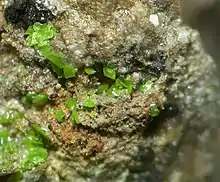| Sengierite | |
|---|---|
 | |
| General | |
| Category | Oxide and Hydroxide |
| Formula (repeating unit) | Cu2(OH)2[UO2|VO4]2·6H2O |
| IMA symbol | Sgi[1] |
| Crystal system | Monoclinic |
| Space group | Monoclinic 2/m |
| Identification | |
| Color | Olive-green, yellowish green |
| Crystal habit | Flattened thin plates, coatings |
| Cleavage | Perfect on {001} |
| Tenacity | Brittle |
| Mohs scale hardness | 2.5 |
| Luster | Adamantine, Vitreous |
| Streak | Light green |
| Diaphaneity | Transparent |
| Specific gravity | 4.05 |
| Density | 4.05 g/cm3 (Measured) 4.1 g/cm3 (Calculated) |
| Refractive index | nα = 1.760 - 1.770 nβ = 1.920 - 1.940 nγ = 1.940 - 1.970 |
| Pleochroism | X: Bluish green, Y: Olive-green, Z: Yellowish green to colorless |
| 2V angle | Measured: 37° to 39°, Calculated: 36° |
| Other characteristics | |
Sengierite is a rare oxide and hydroxide mineral, chemically a copper and uranyl vanadate, belonging to the carnotite group. Its chemical formula is Cu2(OH)2[UO2|VO4]2·6H2O.[2][3]
Sengierite was first discovered at the Luiswishi Mine about 20 kilometres (12 mi) north of Lubumbashi in Katanga Province in the Democratic Republic of the Congo and was first described in 1949 by Johannes F. Vaes and Paul F. Kerr, the mineral was named after Edgar Sengier (1879–1963), a former Director of the Union Minière du Haut Katanga.[4]
References
- ↑ Warr, L.N. (2021). "IMA–CNMNC approved mineral symbols". Mineralogical Magazine. 85 (3): 291–320. Bibcode:2021MinM...85..291W. doi:10.1180/mgm.2021.43. S2CID 235729616.
- ↑ "Sengierite: Sengierite mineral information and data". mindat.org. Retrieved 2018-08-09.
- ↑ John W. Anthony, Richard A. Bideaux, Kenneth W. Bladh, and Monte C. Nichols, Eds., Handbook of Mineralogy, Mineralogical Society of America, Chantilly, VA 20151-1110, USA. PDF
- ↑ J. F. Vaes; Paul F. Kerr (1949). "Sengierite: a preliminary description" (PDF). American Mineralogist. 34: 109–120.
Bibliography
- Palache, P.; Berman H.; Frondel, C. (1960). "Dana's System of Mineralogy, Volume II: Halides, Nitrates, Borates, Carbonates, Sulfates, Phosphates, Arsenates, Tungstates, Molybdates, Etc. (Seventh Edition)" John Wiley and Sons, Inc., New York, pp. 1047-1048.
This article is issued from Wikipedia. The text is licensed under Creative Commons - Attribution - Sharealike. Additional terms may apply for the media files.